Multiplatform Earth Observation Systems for Monitoring Water Quality in Vulnerable Inland Ecosystems: Maspalomas Water Lagoon
Abstract
1. Introduction
2. Methodology
2.1. Study Area
2.2. Multisensor Remotely Sensed and In Situ Field Data
- In June 2017, in situ data was acquired simultaneously to the AHS campaign. As shown in Figure 3, a total of three points were sampled at three different depths to measure water quality parameters (red points) using an IDRONAUT multiparameter probe. Precise information about the latitude, longitude and time were provided by a Trimble DSM132 Global Navigation Satellite System(GNSS) receiver. Additional sites monitored during 2015 were also used in the analysis. During the 2017 campaign, reflectance measurements were collected using the ASD FieldSpec3 precision radiometer. The procedure described in [21] was followed, measuring the radiance emanating from the water surface at a zenith angle between 30° and 50° and with an azimuth angle between 90° and 180° relative to the sun’s azimuth. The procedure was replicated five times and the mean and standard deviation value were derived. A MICROTOPS II solar light meter was also used and a subsequent processing was performed to get the reflectance [22].
- In June, 2018, another field campaign was performed along with a drone flight. As shown in Figure 3, a total of three points were sampled (blue points) near to the lagoon shore measuring turbidity, chlorophyll-a/b and carothenoids using a Hydrolab HL4 multiparameter probe. A HYPER-V GNSS was used to get the time and precise coordinates.
- During July, 2019, in situ data was also collected simultaneously to the drone flight. A total of seven points were sampled (black in Figure 3); however, for the two locations in the center of the lagoon, samples at two depths were collected. In this campaign, more specific water parameters were measured; specifically, Chl-a, Chl-b, turbidity, CDOM, carotenoids, phycobiliproteins and functional groups of planktonic microalgae. In addition, bathymetry and the geographic coordinates and time of each sampled were obtained.
2.3. Multiplatform Water Quality Monitoring
2.3.1. Radiometric and Atmospheric Corrections
2.3.2. Water Column Modeling and Chlorophyll-A Estimation
3. Results
3.1. Satellite/Airborne Atmospheric Algorithms Assessment
3.2. Inner Lake Monitoring: Chlorophyll-A Concentration
4. Discussion
5. Conclusions
Author Contributions
Funding
Acknowledgments
Conflicts of Interest
References
- Horning, E.; Robinson, J.; Sterling, E.; Turner, W.; Spector, S. Remote Sensing for Ecology and Conservation; Oxford University Press: New York, NY, USA, 2010. [Google Scholar]
- Purkis, S.; Klemas, V. Remote Sensing and Global Environmental Change; John Wiley & Sons Ltd.: Oxford, UK, 2011. [Google Scholar]
- Richards, J.A. Remote Sensing Digital Image Analysis, 5th ed.; Springer: Berlin, Germany, 2013; ISBN 978-3-54-029711-6. [Google Scholar]
- Gholizadeh, M.H.; Melesse, A.M.; Reddi, L. A comprehensive review on water quality parameters estimation using remote sensing techniques. Sensors 2016, 16, 1298. [Google Scholar] [CrossRef] [PubMed]
- Palmer, S.C.J.; Kutser, P.; Hunter, D. Remote sensing of inland waters: Challenges, progress and future directions. Remote Sens. Environ. 2015, 157, 1–8. [Google Scholar] [CrossRef]
- Bonanseaa, M.; Rodriguez, M.C.; Pinottic, L.; Ferrerod, S. Using multi-temporal Landsat imagery and linear mixed models for assessing water quality parameters in Río Tercero reservoir (Argentina). Remote Sens. Environ. 2015, 158, 28–41. [Google Scholar] [CrossRef]
- Toming, K.; Kutser, T.; Uiboupin, R.; Arikas, A.; Vahter, K.; Paavel, B. Mapping water quality parameters with sentinel-3 ocean and land colour instrument imagery in the Baltic sea. Remote Sens. 2017, 9, 1070. [Google Scholar] [CrossRef]
- Eugenio, F.; Marcello, J.; Martin, J. High-resolution maps of bathymetry and benthic habitats in shallow-water environments using multispectral remote sensing imagery. IEEE Trans. Geosci. Remote Sens. 2015, 53, 3539–3549. [Google Scholar] [CrossRef]
- Martin, J.; Eugenio, F.; Marcello, J.; Medina, A. Automatic sunglint removal of multispectral high-resolution worldview-2 imagery for retrieving coastal shallow water parameters. Remote Sens. 2016, 8, 37. [Google Scholar] [CrossRef]
- Eugenio, F.; Marcello, J.; Martin, J.; Rodríguez-Esparragón, D. Benthic habitat mapping using multispectral high-resolution imagery: evaluation of shallow water atmospheric correction techniques. Sensors 2017, 17, 2639. [Google Scholar] [CrossRef]
- Fichot, C.; Downing, B.; Bergamaschi, B.; Windham-Myers, L.; Marvin-Dipasquale, M.; Thompson, D.; Gierach, M. High-resolution remote sensing of water quality in the San Francisco bay-delta estuary. Environ. Sci. Technol. 2016, 50, 573–583. [Google Scholar] [CrossRef]
- Zheng, G.; Di Giacomo, P.M. Uncertainties and applications of satellite-derived coastal water quality products. Prog. Oceanogr. 2017, 159, 45–72. [Google Scholar] [CrossRef]
- Zhanga, Y.; Huang, Z.; Fu, D.; Yeu, J.; Tingchen, T.; Jiang, X.; Liang, S.; Lu, X. Monitoring of chlorophyll-a and sea surface silicate concentrations in the south part of Cheju island in the East China sea using MODIS data. Int. J. Appl. Earth Obs. Geoinf. 2018, 67, 173–178. [Google Scholar] [CrossRef]
- Koparan, C.; Koc, A.B.; Privette, C.V.; Sawyer, C.B. In situ water quality measurements using an Unmanned Aerial Vehicle (UAV) system. Water 2018, 10, 264. [Google Scholar] [CrossRef]
- Haoa, Q.; Chai, F.; Xiu, P.; Bai, Y.; Chen, J.; Liu, C.; Le, F.; Zhou, F. Spatial and temporal variation in chlorophyll a concentration in the Eastern China Seas based on a locally modified satellite dataset. Estuar. Coast. Shelf Sci. 2019, 220, 220–231. [Google Scholar] [CrossRef]
- Qi, L.; Lee, Z.; Hu, C.; Wang, M. Requirement of minimal signal-to-noise ratios of ocean color sensors and uncertainties of ocean color products. J. Geophys. Res. Ocean. 2017, 122. [Google Scholar] [CrossRef]
- Wang, Y. Remote Sensing of Coastal Environments; Taylor and Francis Series; CRC Press: Borarton, FL, USA, 2010; ISBN 978-1-42-009442-8. [Google Scholar]
- González-Henríquez, N.; Soler-Onís, E.; Moreno, T.; Castro-Hernández, J.; Betancort-Yllalba, M.J. Estudio de la dinámica del ecosistema del charco de Maspalomas (1992–1998), Gran Canaria. Inf. Técnicos Inst. Canario Cienc. Mar. 1999, 6, 1–76. [Google Scholar]
- Digital Globe. Accuracy of Worldview Products. White Paper. 2016. Available online: https://dg-cms-uploads-production.s3.amazonaws.com/uploads/document/file/38/DG_ACCURACY_WP_V3.pdf (accessed on 2 February 2019).
- De Miguel, E.; Fernández-Renau, A.; Prado, E.; Jiménez, M.; Gutiérrez, O.; Linés, C.; Gómez, J.; Martín, A.I.; Muñoz, F. A review of INTA AHS PAF. EARSeL eProc. 2014, 13, 20–29. [Google Scholar]
- Mueller, J.L.; Davis, C.; Arnone, R.; Frouin, R.; Carder, K.; Lee, Z.P.; Steward, R.G.; Hooker, S.; Mobley, C.D.; McLean, S. Above-water radiance and remote sensing reflectance measurement and analysis protocols, Chapter 10. In Ocean Optics Protocols for Satellite Ocean Color Sensor Validation; Revision 2; Giulietta, S., Fargion, G.S., Mueller, J.L., Eds.; NASA-GSFSC: Greenbelt, MD, USA, 2003. [Google Scholar]
- Jiménez, M.; González, M.; Amaro, A.; Fernández-Renau, A. Field spectroscopy metadata system based on ISO and OGC standards. ISPRS Int. J. Geo-Inf. 2014, 3, 1003–1022. [Google Scholar]
- Eugenio, F.; Martin, J.; Marcello, J.; Fraile-Nuez, E. Environmental monitoring of El Hierro Island submarine volcano, by combining low and high resolution satellite imagery. Int. J. Appl. Earth Obs. Geoinf. 2014, 29, 53–66. [Google Scholar] [CrossRef]
- Rani, N.; Mandla, V.R.; Singh, T. Evaluation of atmospheric corrections on hyperspectral data with special reference to mineral mapping. Geosci. Front. 2017, 8, 797–808. [Google Scholar] [CrossRef]
- Mahiny, A.S.; Turner, B.J. A comparison of four common atmospheric correction methods. Photogramm. Eng. Remote Sens. 2007, 73, 361–368. [Google Scholar] [CrossRef]
- Jaelani, L.M.; Matsushita, B.; Yang, W.; Fukushima, T. An improved atmospheric correction algorithm for applying MERIS data to very turbid inland waters. Int. J. Appl. Earth Obs. Geoinf. 2015, 39, 128–141. [Google Scholar] [CrossRef]
- Richter, R.; Schläpfer, D. Atmospheric/Topographic Correction for Airborne Imagery: ATCOR-4 User Guide; Version 7.0.3; DLR and ReSe Report: Wessling, Germany, 2016. [Google Scholar]
- Manessa, M.D.M.; Haidar, M.; Budhiman, S.; Winarso, G.; Kanno, A.; Sagawa, T.; Sekine, M. Evaluating the performance of Lyzenga’s water column correction in case-1 coral reef water using a simulated Worldview-2 imagery. In Proceedings of the IOP Conference Series: Earth and Environmental Science, Shanghai, China, 23–26 July 2016; Volume 47. [Google Scholar]
- Lee, Z.; Carder, K.L.; Mobley, C.D.; Steward, R.G.; Patch, J.S. Hyperspectral remote sensing for shallow waters: 1. A semi-analytical model. Appl. Opt. 1998, 37, 6329–6338. [Google Scholar] [CrossRef] [PubMed]
- Lee, Z.; Carder, K.L.; Mobley, C.D.; Steward, R.G.; Patch, J.S. Hyperspectral remote sensing for shallow waters: 2. Deriving bottom depths and water properties by optimization. Appl. Opt. 1999, 38, 3831–3843. [Google Scholar] [CrossRef] [PubMed]
- Heylen, R.; Burazerović, D.; Scheunders, P. Fully constrained least squares spectral unmixing by simplex projection. IEEE Trans. Geosci. Remote Sens. 2011, 49, 4112–4122. [Google Scholar] [CrossRef]
- Gordon, H.R.; Brown, O.B.; Jacobs, M.M. Computed relationships between the inherent and apparent optical properties of a flat homogeneous ocean. Appl. Opt. 1975, 14, 417–427. [Google Scholar] [CrossRef] [PubMed]
- Albert, A.; Mobley, C. An analytical model for subsurface irradiance and remote sensing reflectance in deep and shallow case-2 waters. Opt. Express 2003, 11, 2873–2890. [Google Scholar] [CrossRef] [PubMed]
- Gavin, H.P. The Levenberg-Marquardt Method for Nonlinear Least Squares Curve-Fitting Problems; Department of Civil and Environmental Engineering, Duke University: Durham, NC, USA, 2011; pp. 1–15. [Google Scholar]
- Korosov, A.; Moiseev, A.; Shuchman, R.A.; Pozdnyakov, D. Modis-aqua and sentinel-2 data fusion: Application to optically shallow waters of Lake Michigan. Karelian Res. Cent. Russ. Acad. Sci. 2017. [Google Scholar] [CrossRef][Green Version]
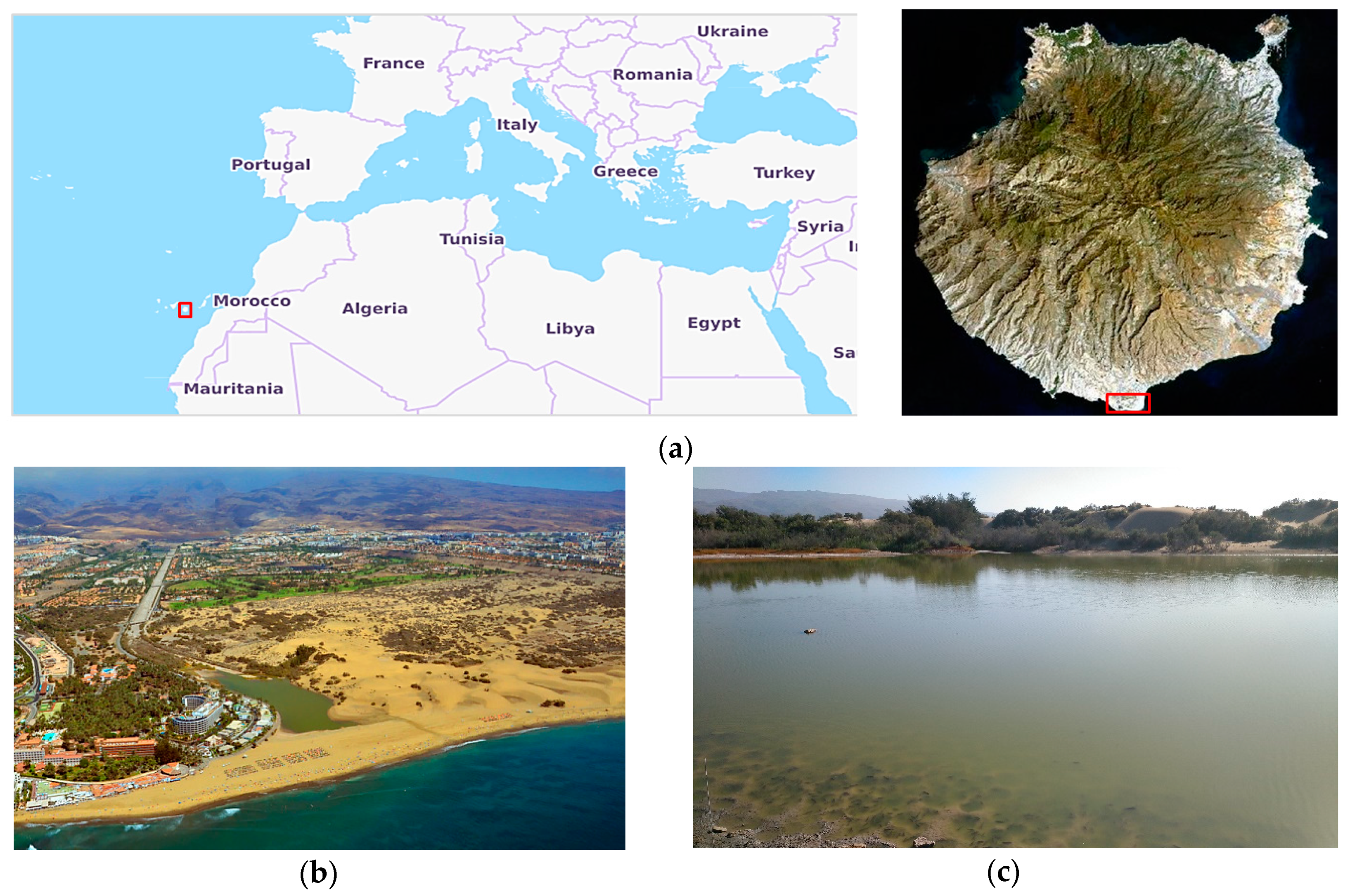
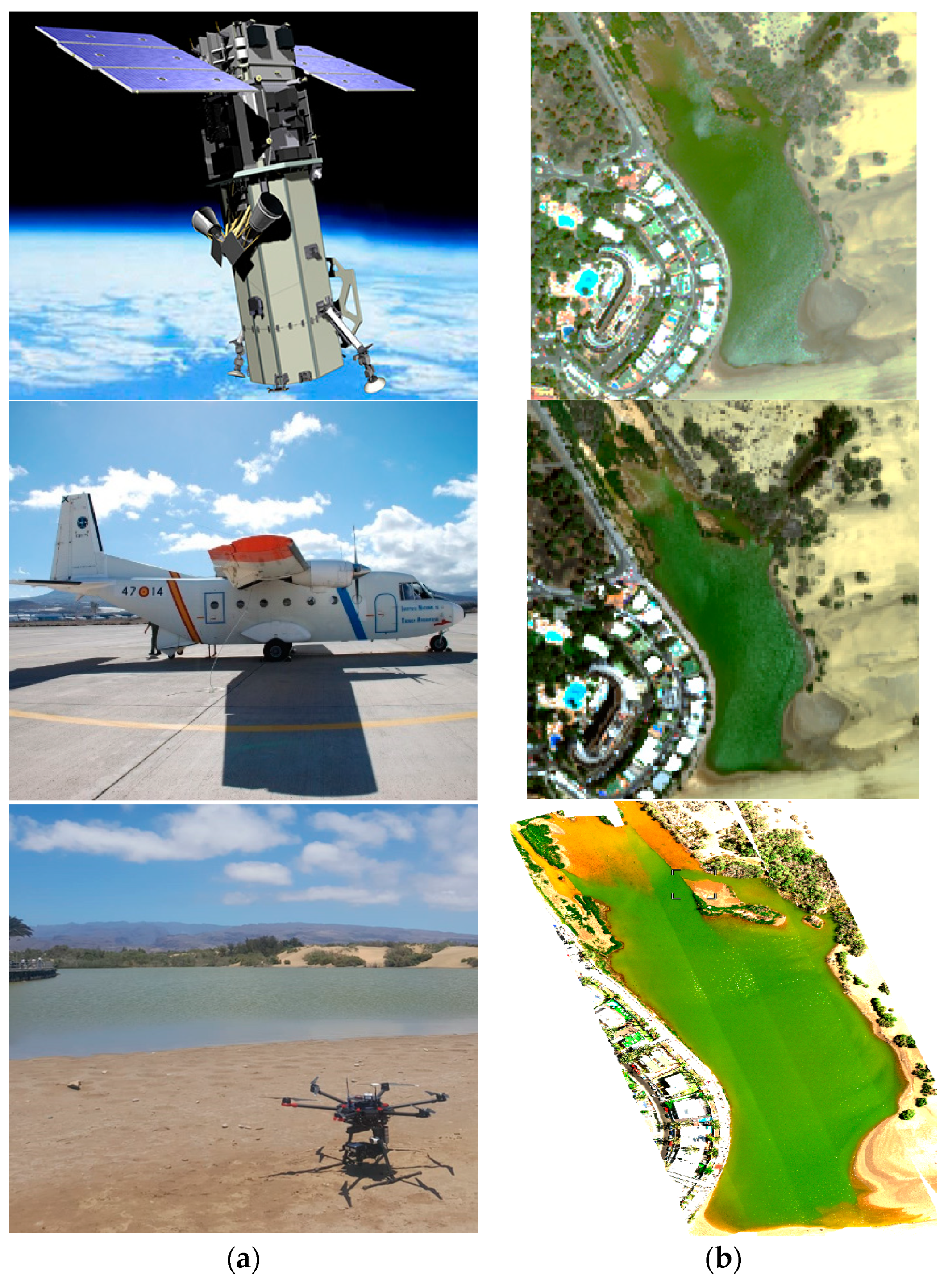
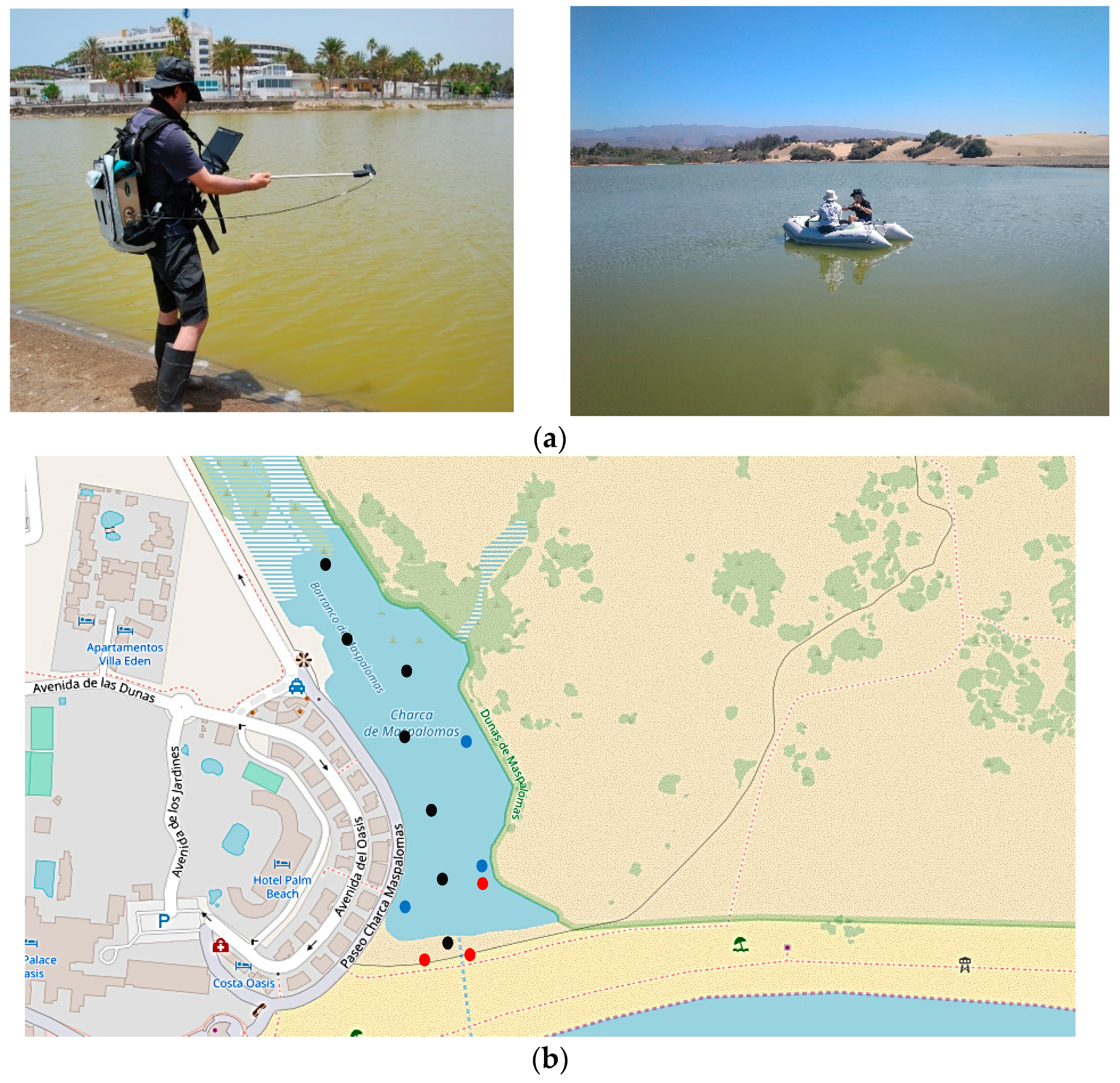
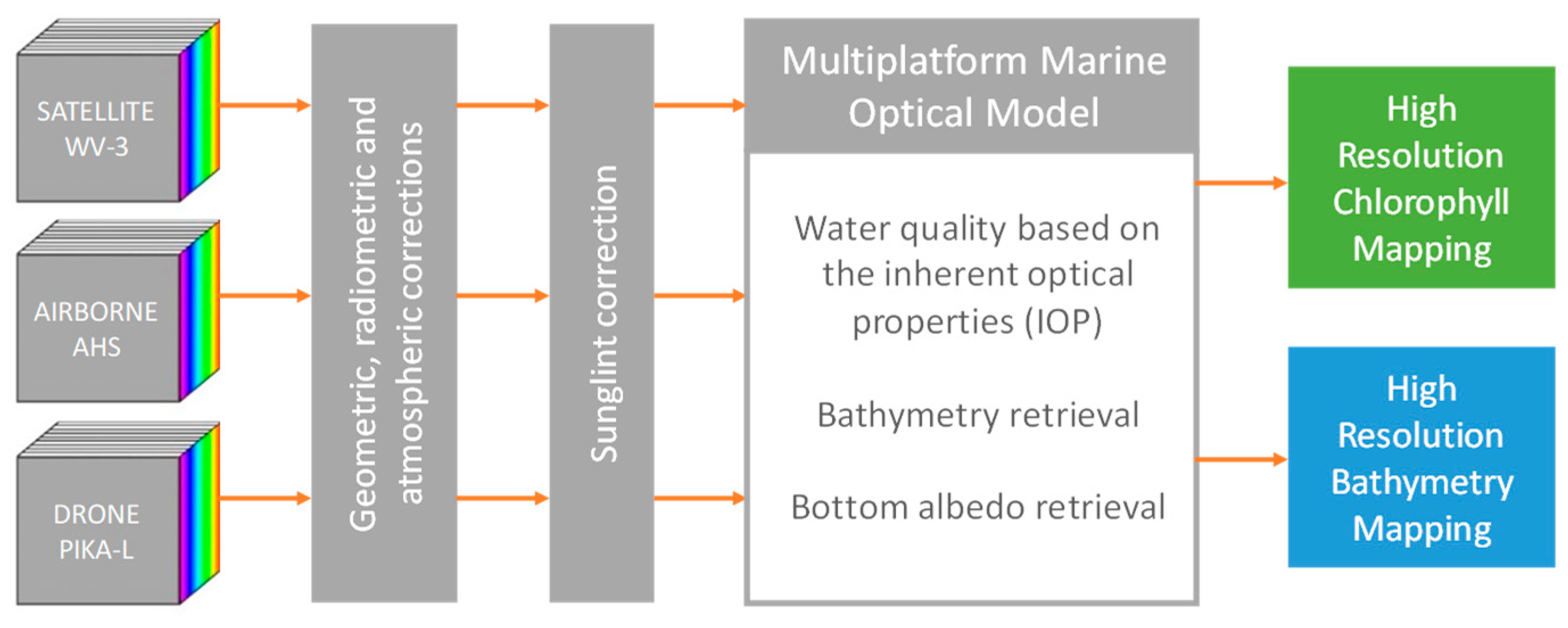
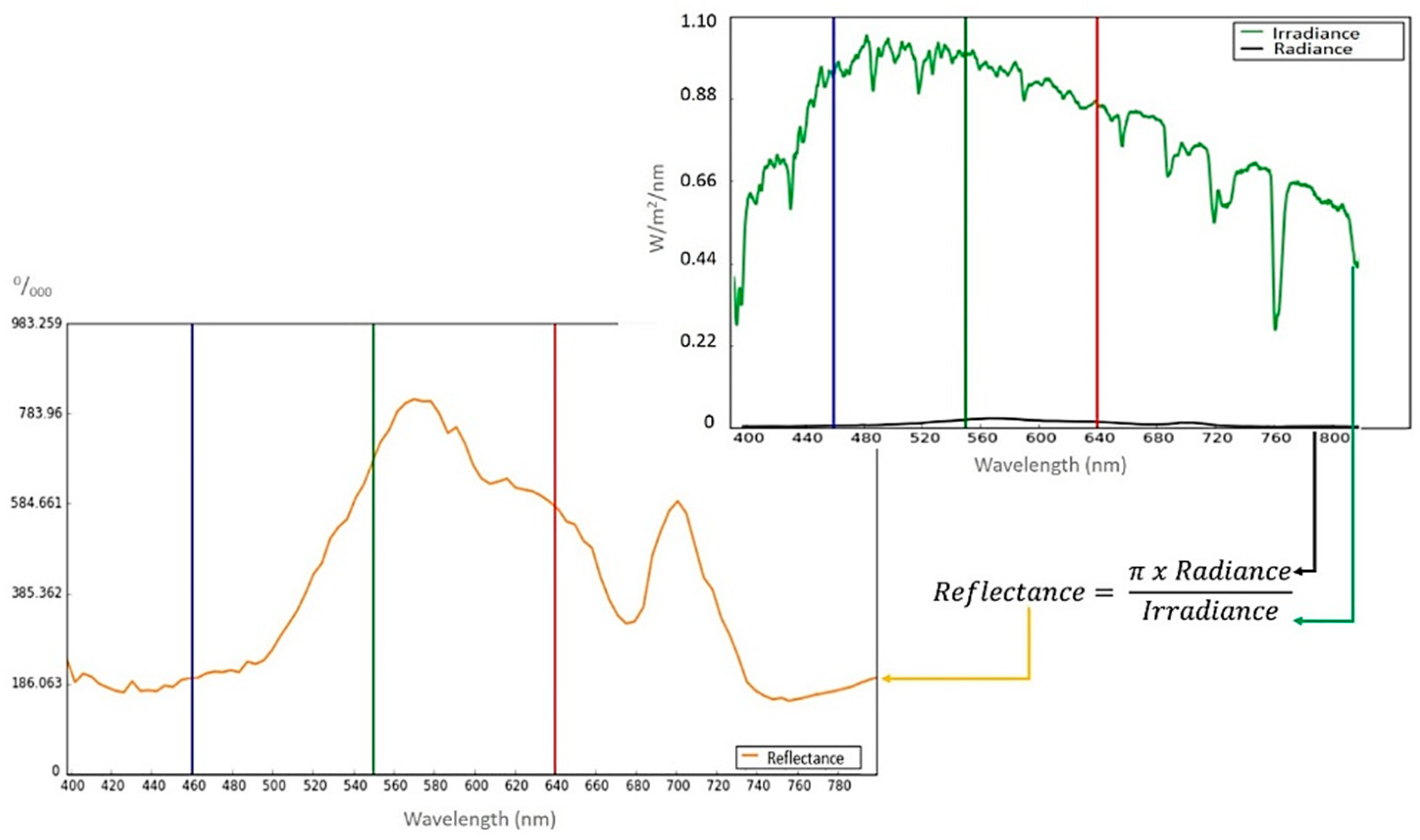
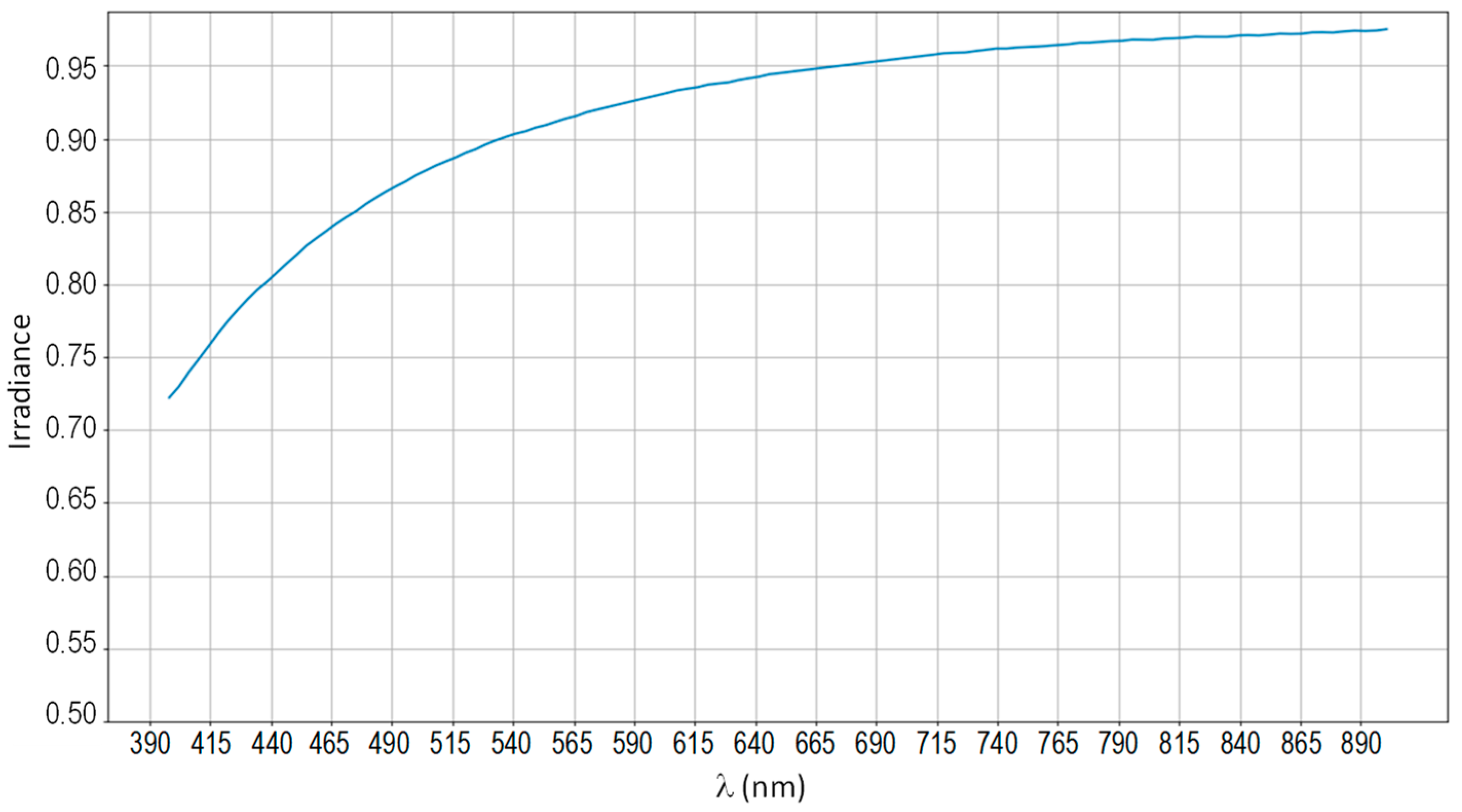
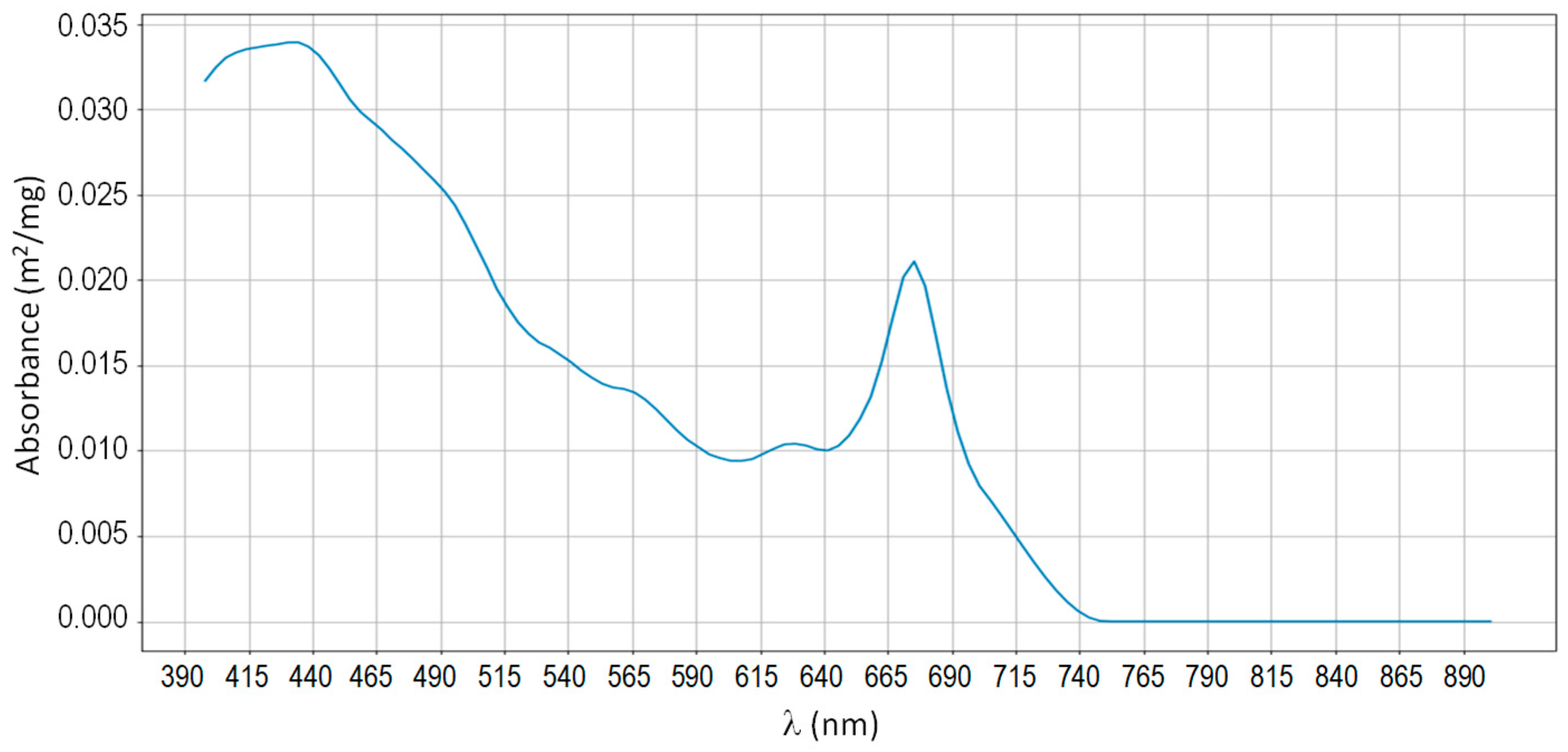
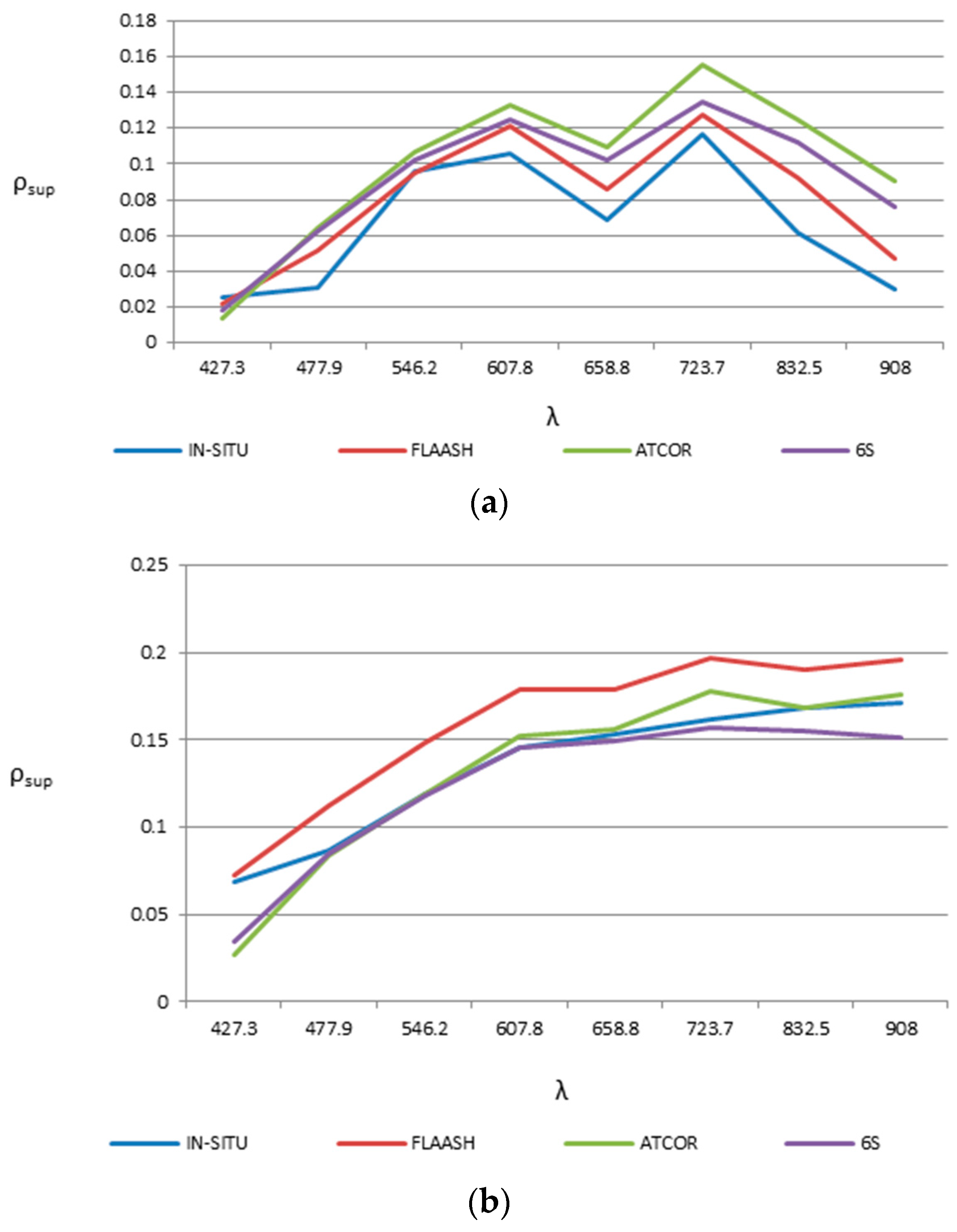
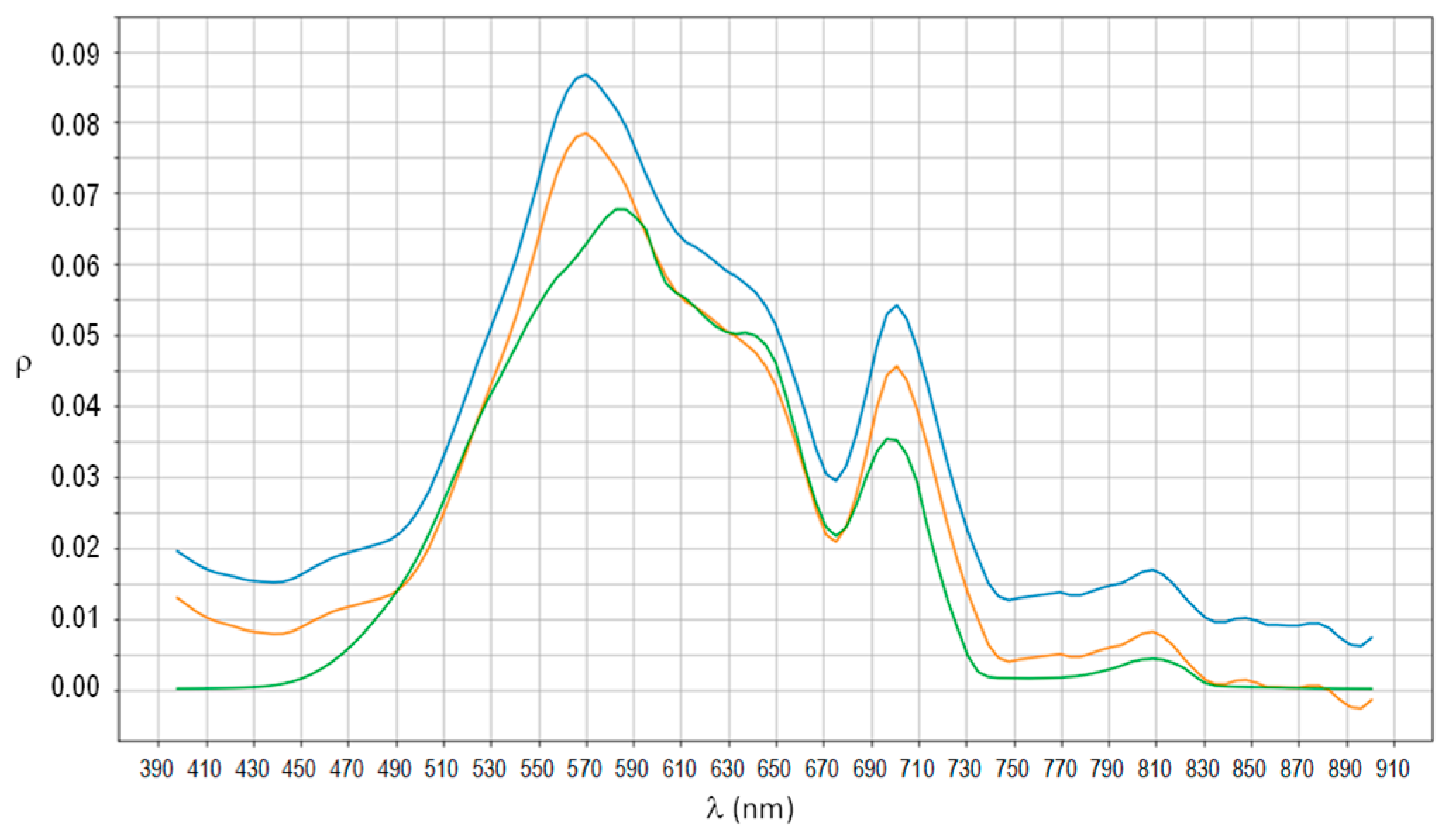
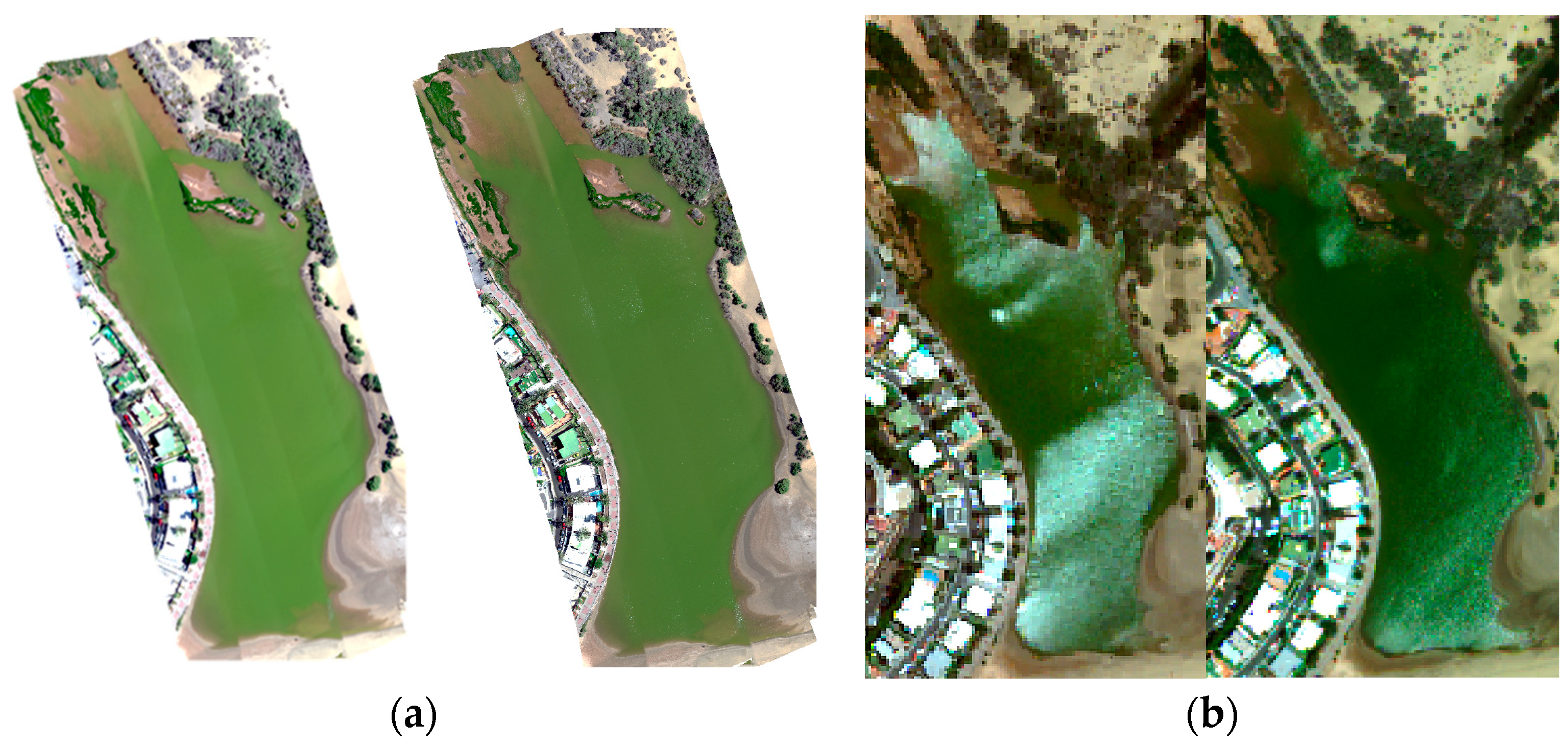
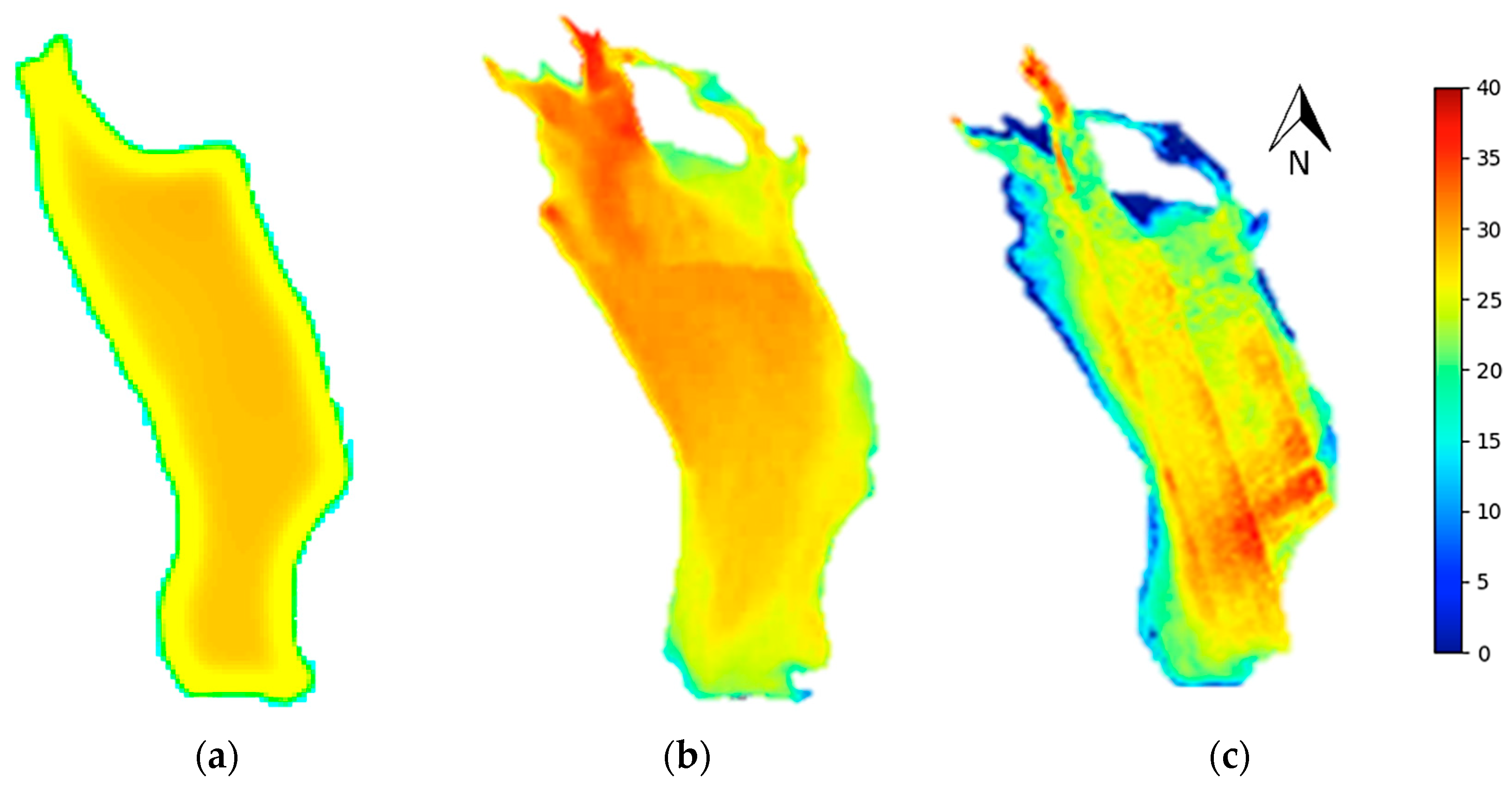
| PLATFORM SENSOR | Spatial Resolution (m) | Spectral Band | Wavelength (nm) | Bandwidth (nm) |
|---|---|---|---|---|
| SATELLITE WorldView-3 | 1.6 | Coastal Blue | 400–450 | 47.3 |
| Blue | 450–510 | 54.3 | ||
| Green | 510–580 | 63.0 | ||
| Yellow | 585–625 | 37.4 | ||
| Red | 630–690 | 57.4 | ||
| Red-edge | 705–745 | 39.3 | ||
| Near-IR 1 | 770–895 | 98.9 | ||
| Near-IR 2 | 860–1040 | 99.6 | ||
| Panchromatic | 450–800 | 284.6 | ||
| AIRBORNE AHS | 2.5 | Visible and Near-IR (20 channels) | 434–1015 | 28–30 |
| DRONE PIKA-L | 0.1 | Visible and Near-IR (150 channels) | 400–1000 nm | 4 |
| Date | Chl-a | Other Field Data Acquisition |
|---|---|---|
| 2 June 2017 | 3 (9) | Reflectance (ADS Fieldspec 3) Temperature at 3 depths Time and location |
| 4 June 2018 | 3 | Time and location |
| 23 July 2019 | 7 (9) | Carotenoids, phycobiliproteins, functional groups of planktonic microalgae Bathymetry, time and location |
| Algorithm | Sensor/Platform | RMSE | BIAS |
|---|---|---|---|
| FLAASH | WV/Satellite | 0.1014 | −0.0348 |
| ATCOR | AHS/Airborne | 0.0318 | −0.0251 |
| Sensor | Mean Estimated | Mean in Situ | RMSE | BIAS |
|---|---|---|---|---|
| Wolrdview-3 | 17.53 | 14.94 | 6.75 | 6.47 |
| AHS | 19.94 | 14.94 | 6.65 | 5.58 |
| Pika—L | 17.97 | 16.20 | 3.49 | 2.96 |
© 2020 by the authors. Licensee MDPI, Basel, Switzerland. This article is an open access article distributed under the terms and conditions of the Creative Commons Attribution (CC BY) license (http://creativecommons.org/licenses/by/4.0/).
Share and Cite
Eugenio, F.; Marcello, J.; Martín, J. Multiplatform Earth Observation Systems for Monitoring Water Quality in Vulnerable Inland Ecosystems: Maspalomas Water Lagoon. Remote Sens. 2020, 12, 284. https://doi.org/10.3390/rs12020284
Eugenio F, Marcello J, Martín J. Multiplatform Earth Observation Systems for Monitoring Water Quality in Vulnerable Inland Ecosystems: Maspalomas Water Lagoon. Remote Sensing. 2020; 12(2):284. https://doi.org/10.3390/rs12020284
Chicago/Turabian StyleEugenio, Francisco, Javier Marcello, and Javier Martín. 2020. "Multiplatform Earth Observation Systems for Monitoring Water Quality in Vulnerable Inland Ecosystems: Maspalomas Water Lagoon" Remote Sensing 12, no. 2: 284. https://doi.org/10.3390/rs12020284
APA StyleEugenio, F., Marcello, J., & Martín, J. (2020). Multiplatform Earth Observation Systems for Monitoring Water Quality in Vulnerable Inland Ecosystems: Maspalomas Water Lagoon. Remote Sensing, 12(2), 284. https://doi.org/10.3390/rs12020284







